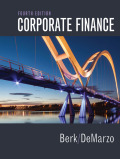
EBK CORPORATE FINANCE
4th Edition
ISBN: 8220103145947
Author: DeMarzo
Publisher: PEARSON
expand_more
expand_more
format_list_bulleted
Concept explainers
Question
Chapter 26.3, Problem 2CC
Summary Introduction
To discuss: The difference between accounts receivable days and an aging schedule.
Introduction:
The number of outstanding days the customer has to pay the firm is termed as accounts receivable days. The table content of summarized division of accounts receivables on different time zone is termed as aging schedule. It shows the span of time of unpaid customers according to the dates which is used to check the due list.
Expert Solution & Answer
Want to see the full answer?
Check out a sample textbook solution
Students have asked these similar questions
Finance problem solve
Need answer for this.
Need asst. pls
Chapter 26 Solutions
EBK CORPORATE FINANCE
Ch. 26.1 - What is the firms cash cycle? How does it differ...Ch. 26.1 - How does working capital impact a firms value?Ch. 26.2 - Prob. 1CCCh. 26.2 - Prob. 2CCCh. 26.3 - Prob. 1CCCh. 26.3 - Prob. 2CCCh. 26.4 - What is accounts payable days outstanding?Ch. 26.4 - What are the costs of stretching accounts payable?Ch. 26.5 - What are the benefits and costs of holding...Ch. 26.5 - Prob. 2CC
Ch. 26.6 - Prob. 1CCCh. 26.6 - Prob. 2CCCh. 26 - Prob. 1PCh. 26 - Prob. 2PCh. 26 - Aberdeen Outboard Motors is contemplating building...Ch. 26 - Prob. 4PCh. 26 - Prob. 5PCh. 26 - Prob. 6PCh. 26 - The Fast Reader Company supplies bulletin board...Ch. 26 - Prob. 8PCh. 26 - Prob. 9PCh. 26 - Prob. 10PCh. 26 - The Mighty Power Tool Company has the following...Ch. 26 - What is meant by stretching the accounts payable?Ch. 26 - Prob. 13PCh. 26 - Your firm purchases goods from its supplier on...Ch. 26 - Use the financial statements supplied on the next...Ch. 26 - Prob. 16PCh. 26 - Which of the following short-term securities would...
Knowledge Booster
Learn more about
Need a deep-dive on the concept behind this application? Look no further. Learn more about this topic, finance and related others by exploring similar questions and additional content below.Similar questions
arrow_back_ios
SEE MORE QUESTIONS
arrow_forward_ios
Recommended textbooks for you
 Cornerstones of Cost Management (Cornerstones Ser...AccountingISBN:9781305970663Author:Don R. Hansen, Maryanne M. MowenPublisher:Cengage LearningPrinciples of Accounting Volume 1AccountingISBN:9781947172685Author:OpenStaxPublisher:OpenStax College
Cornerstones of Cost Management (Cornerstones Ser...AccountingISBN:9781305970663Author:Don R. Hansen, Maryanne M. MowenPublisher:Cengage LearningPrinciples of Accounting Volume 1AccountingISBN:9781947172685Author:OpenStaxPublisher:OpenStax College College Accounting, Chapters 1-27AccountingISBN:9781337794756Author:HEINTZ, James A.Publisher:Cengage Learning,
College Accounting, Chapters 1-27AccountingISBN:9781337794756Author:HEINTZ, James A.Publisher:Cengage Learning, College Accounting (Book Only): A Career ApproachAccountingISBN:9781337280570Author:Scott, Cathy J.Publisher:South-Western College PubCentury 21 Accounting Multicolumn JournalAccountingISBN:9781337679503Author:GilbertsonPublisher:Cengage
College Accounting (Book Only): A Career ApproachAccountingISBN:9781337280570Author:Scott, Cathy J.Publisher:South-Western College PubCentury 21 Accounting Multicolumn JournalAccountingISBN:9781337679503Author:GilbertsonPublisher:Cengage

Cornerstones of Cost Management (Cornerstones Ser...
Accounting
ISBN:9781305970663
Author:Don R. Hansen, Maryanne M. Mowen
Publisher:Cengage Learning

Principles of Accounting Volume 1
Accounting
ISBN:9781947172685
Author:OpenStax
Publisher:OpenStax College

College Accounting, Chapters 1-27
Accounting
ISBN:9781337794756
Author:HEINTZ, James A.
Publisher:Cengage Learning,

College Accounting (Book Only): A Career Approach
Accounting
ISBN:9781337280570
Author:Scott, Cathy J.
Publisher:South-Western College Pub

Century 21 Accounting Multicolumn Journal
Accounting
ISBN:9781337679503
Author:Gilbertson
Publisher:Cengage

Accounts Receivable and Accounts Payable; Author: The Finance Storyteller;https://www.youtube.com/watch?v=x_aUWbQa878;License: Standard Youtube License